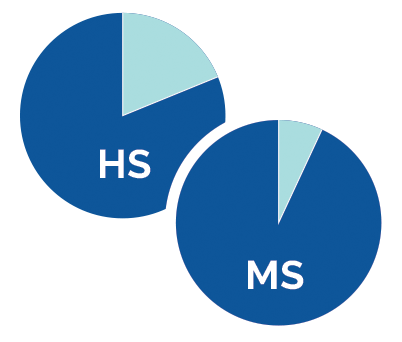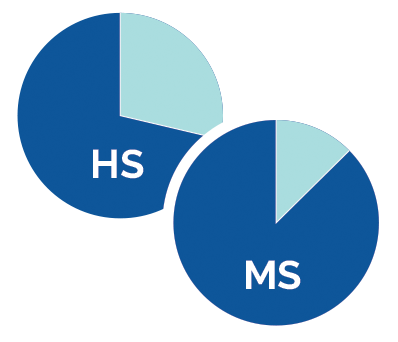What Are E-Cigarettes?
E-cigarettes, also known as vapes, e-cigs, or vape pens, are battery-operated devices that heat a liquid (called e-liquid or vape juice) into an aerosol that users inhale. These products come in many shapes and sizes, often resembling everyday items like USB drives or pens, making them easy to hide.
Most e-cigarettes contain nicotine, the same addictive substance found in regular cigarettes. They also contain flavorings and other chemicals, some of which can be harmful when inhaled.
How Many Youth are Using Tobacco?
 | 20.1% of ND High school students and 8.9% of ND Middle School students who ever smoked a cigarette. |  | 31.6% of ND High School students and 14.5% of Middle School students have reported using an electronic vaping product. | |
 | 5.4% of ND High School students and 2.6% of ND Middle School students who currently smoke. |  | 18.2% of ND High School students and 7.6% of ND Middle School students report they are currently using an electronic vaping product. | |
| Source: ND YRBS, 2023 | ||||
What Are the Risks for Youth?
Addiction and Brain Development
- Nicotine is highly addictive, especially for young people.
- The brain continues to develop until about age 25. Nicotine exposure during this critical time can impact brain development, affecting memory, learning, and impulse control.
- Early nicotine use increases the risk of addiction to other substances in the future.
Mental Health Effects
- Nicotine addiction can cause mood swings, anxiety, irritability, and difficulty concentrating.
- Withdrawal symptoms, like restlessness and cravings, can interfere with daily life and school performance.
Physical Health Risk
- E-cigarettes expose users to harmful chemicals, including heavy metals and cancer-causing substances.
- Inhaling aerosol from e-cigarettes can irritate the lungs and cause respiratory issues.
- Some e-cigarette batteries have exploded, causing burns and other injuries.
Social and Environmental Concerns
- The aerosol from e-cigarettes is not just “harmless water vapor.” It contains chemicals that can be harmful to bystanders.
- Discarded vape pods and devices contribute to environmental pollution.
What Can You Do as a Parent or Caregiver?
Stay Informed
- Learn about e-cigarettes, their risks, and the ways they are marketed to youth.
- Keep up with trends in vaping products, as new devices and flavors are constantly emerging.
Have Open Conversations
- Talk to your child about vaping early and often. Ask open-ended questions to understand their perspective without judgment.
- Explain the health risks in a way they can relate to, like how vaping can impact sports performance or concentration at school.
Set Clear Expectations
- Establish and communicate clear rules about not using tobacco or e-cigarette products.
- Explain the consequences of breaking these rules, and consistently enforce them.
Be a Good Role Model
- If you use tobacco or vape, consider quitting. Children are more likely to avoid these products if they see their parents making healthy choices.
- Share your experiences if you’ve struggled with nicotine addiction—your honesty can have a powerful impact.
Create a Supportive Environment
- Encourage healthy, positive activities like sports, hobbies, or volunteering, which can reduce curiosity about vaping.
- Know your child’s friends and their parents, and encourage open communication about peer pressure and making safe choices.
- If you discover that your child is vaping, approach the situation with understanding and support
- Reach out to healthcare professionals, school counselors, or local support groups for guidance and resources to help your child quit.
